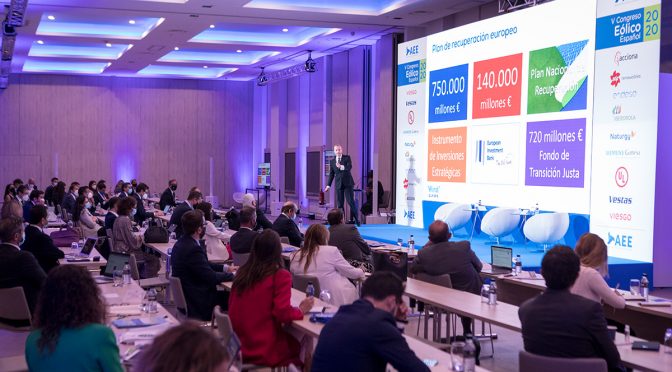On 1 October WindEurope CEO Giles Dickson spoke at the annual Congress of the Spanish wind energy Association (AEE). He described the EU’s ambitions for a green recovery post Covid-19. He explained how Spain and other Member States can make the most of the new instruments available to advance their energy transition. National Recovery Plans in particular will be key to attract EU funds: they will need to be ambitious, concrete and table projects that are easily scalable.
Spain is a wind energy leader, with wind meeting more than 20% of its electricity demand. It’s No. 2 in Europe in installed capacity with 26 GW, and last year it installed more new onshore wind than any other country in Europe. The wind industry employs 24,000 people across the country.
Last April the Spanish government submitted its 2030 National Energy and Climate Plan (NECP), raising the country’s ambitions on greenhouse gas emission reduction to 23% compared to 1990 level. The Plan foresees renewables accounting for 42% of the country’s energy mix and to generating 74% of its electricity by 2030. This entails the installation of 2.2 GW of new wind every year. In May Madrid tabled new climate legislation – a Climate Change and Energy Transition Bill – to reinforce the country‘s commitment to the Paris Climate Agreement and promote green growth as a pillar of its COVID-19 recovery plans.
Now is time for Spain and other countries to ensure that all this ambition is supported by the right measures and policies. The European Commission’s assessment of the final 2030 NECPs submitted by the 27 EU Member States shows some good volume commitments for the expansion of renewables, but also a lack of detail on how Governments will deliver those commitments. Spain’s NECP is truly ambitious in numbers. On the detail, the Government still needs to confirm the arrangements for the onshore wind auctions, though this is expected to come all. And they are taking important steps to simplify the permitting of new wind farms and support the repowering of existing wind farms.
The EU Green Deal will help Member States achieve their climate goals, while limiting the impact of the COVID-19 pandemic on jobs and the economy. The Commission have proposed raising the EU’s greenhouse gas emissions reduction target from 40% by 2030 to at least 55%. And the €750bn EU Recovery Plan, agreed by the European Council will help deliver this. Member States will need to submit their own National Recovery and Resilience Plans to the Commission by April 2021, setting out investment and reform priorities in line with the long-term target of climate neutrality by 2050.
Spain could get up to €140 bn from the Recovery Plan, €60 bn of grants and €80 bn of loans. It could also benefit from the Strategic Investment Facility and the European Central Bank’s InvestEU Programme, focussing on strategic value chains. And get up to €720 m from the Just Transition Fund to support the economic diversification and reconversion of its most deprived territories. In order to make the most of these funds, Spain will need to submit a National Recovery and Resilience Plan that is both ambitious and aligned with its NECP. It will need to show how the funds will increase investment in renewables such as wind, and table projects that are ready to deliver. This is a great opportunity for the wind industry to push for the rolling out of grid infrastructure, ports for offshore wind, roads and bridges as well as infrastructure for renewable hydrogen.


